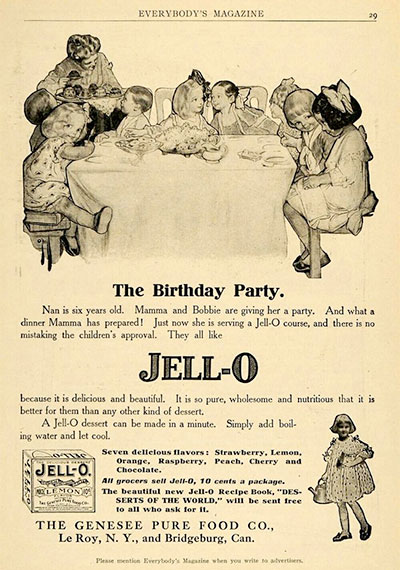The late 1800s were exciting times for everybody.
Well, almost everybody.
The typewriter had been invented, for which I am eternally grateful, even though I haven’t used one for the past couple of decades. (It was good training for using a computer keyboard.)
The telephone had also been invented, just prior to the turn of the century.
And also, Jell-O.
According to the internet, the gelatin in Jell-O is not made from horses hooves, but rather from the skin and bones of cows and pigs. If it were made from horses hooves, I would be hesitant to write about it in a family-friendly magazine. But I often write about cows and pigs, without getting complaints from readers, so my conscience is clear.
Here’s a advertisement from the early 1900s, when there were seven delicious flavors sold at 10 cents a package. Ambitious housewives could order a free recipe book, “Desserts of the World” from the Genesee Pure Food Company. (Readers were asked to mention ‘Everybody’s Magazine’ when they wrote for the free recipe book.)

From what I can tell, ‘Everybody’s Magazine’ was not actually for ‘Everybody’. To judge by the Jell-O advertisement, it would appear that only persons from a certain ethnic group could expect to see themselves in the magazine ads.
80 years later, a spokesperson named Bill Cosby began hawking Jell-O to parents and children.
Mr. Cosby might have represented — in the minds of some Americans — a different ethnic group, although, in my opinion, there was almost nothing in his comedic delivery that would suggest such a difference.
Around this time, Mr. Cosby was also appearing in a very popular TV show, The Cosby Show. (I don’t recall the Huxtable family eating Jell-O, which might strike some people as somewhat surprising, considering there’s always room for Jell-O.)

I assume Mr. Cosby’s later legal troubles did not reflect negatively on the Jell-O brand.
But going back to that earlier time, in the late 1800s, when Jell-O was first invented and successfully marketed, other changes were taking place in America.
You probably remember, from your history classes, the contentious election of 1876, when Democrat Samuel Tilden appeared to have won the popular vote, but Rutherford B. Hayes might have won the electoral college vote.
Might have won.
The electoral college count wasn’t exactly clear-cut because — among other curious events — a train in Florida, sent to collect the ballots, was derailed by the Ku Klux Klan. Why a group of intelligent men would try and prevent a presidential election from being certified, we probably can’t imagine. Maybe they thought the election was being stolen?
President Ulysses S. Grant sent federal troops into the South, to try and collect the votes from three disputed Southern states. To deal with the social unrest and rising threat of violence, Congress convened a special commission to decide the election, and the commission awarded the victory to Rutherford B. Hayes.
But only after Hayes agreed — in obvious violation of the 13th, 14th and 15th Amendments — to allow the South to openly discriminate against Blacks, in pretty much every imaginable way.
I’m not sure what this has to do with Jello-O.
Jell-O currently comes in 15 different colors and flavors.
Americans generally appreciate variety, when it comes to desserts like Jell-O.
Not so much, when it comes to people.
Underrated writer Louis Cannon grew up in the vast American West, although his ex-wife, given the slightest opportunity, will deny that he ever grew up at all. You can read more stories on his Substack account.
